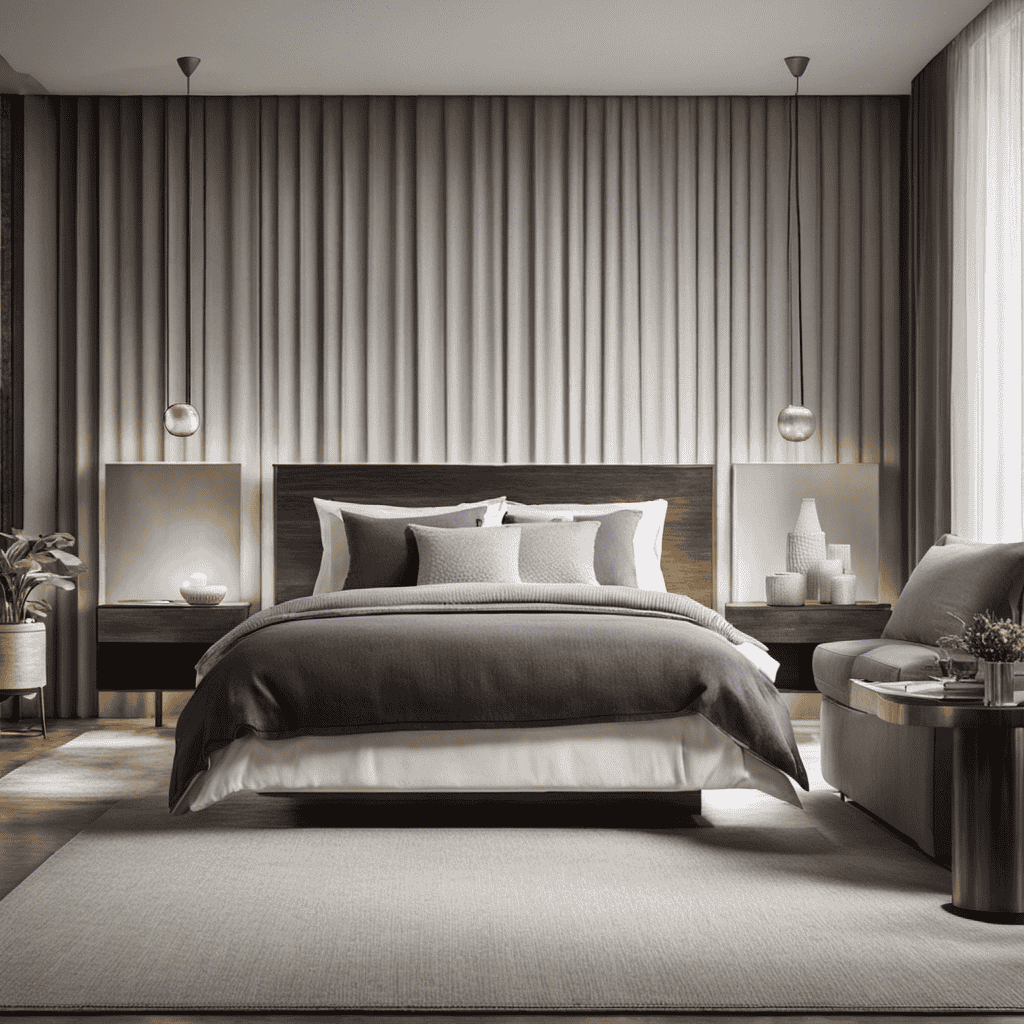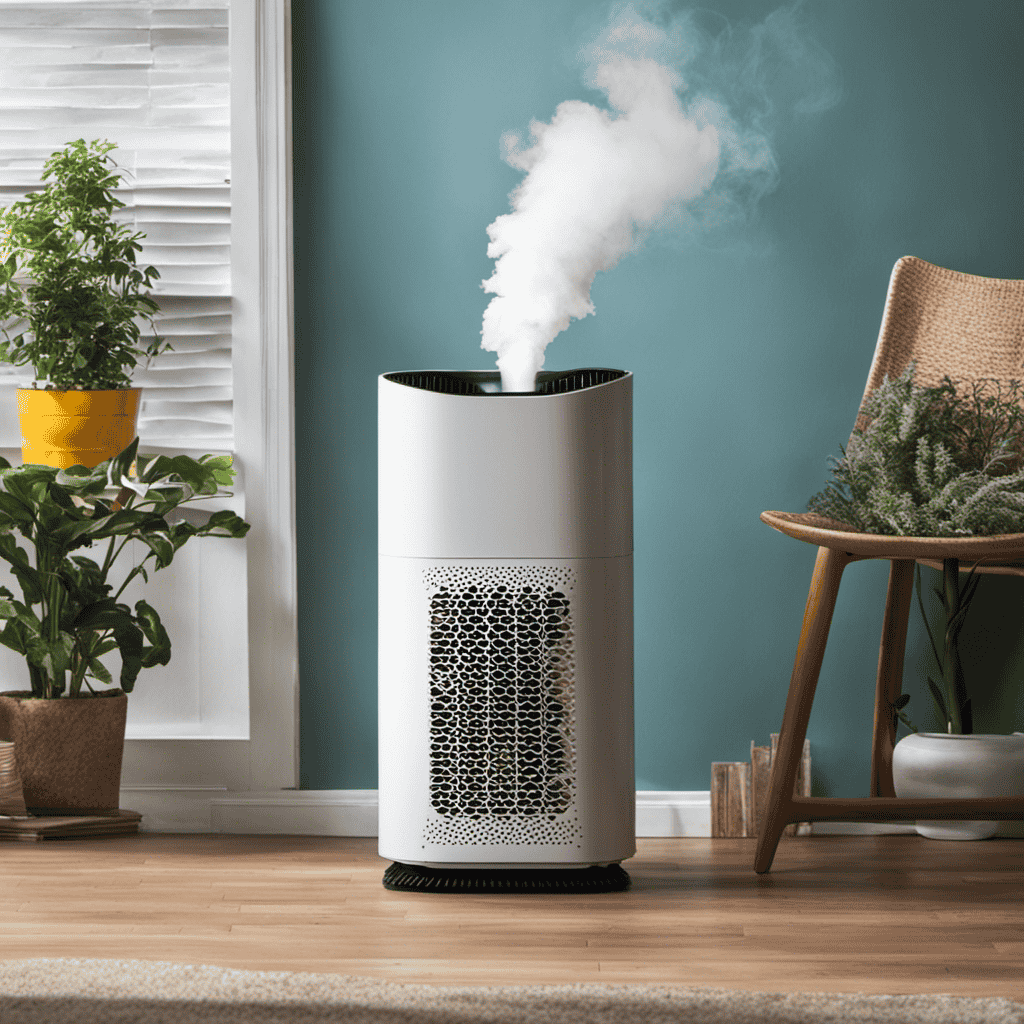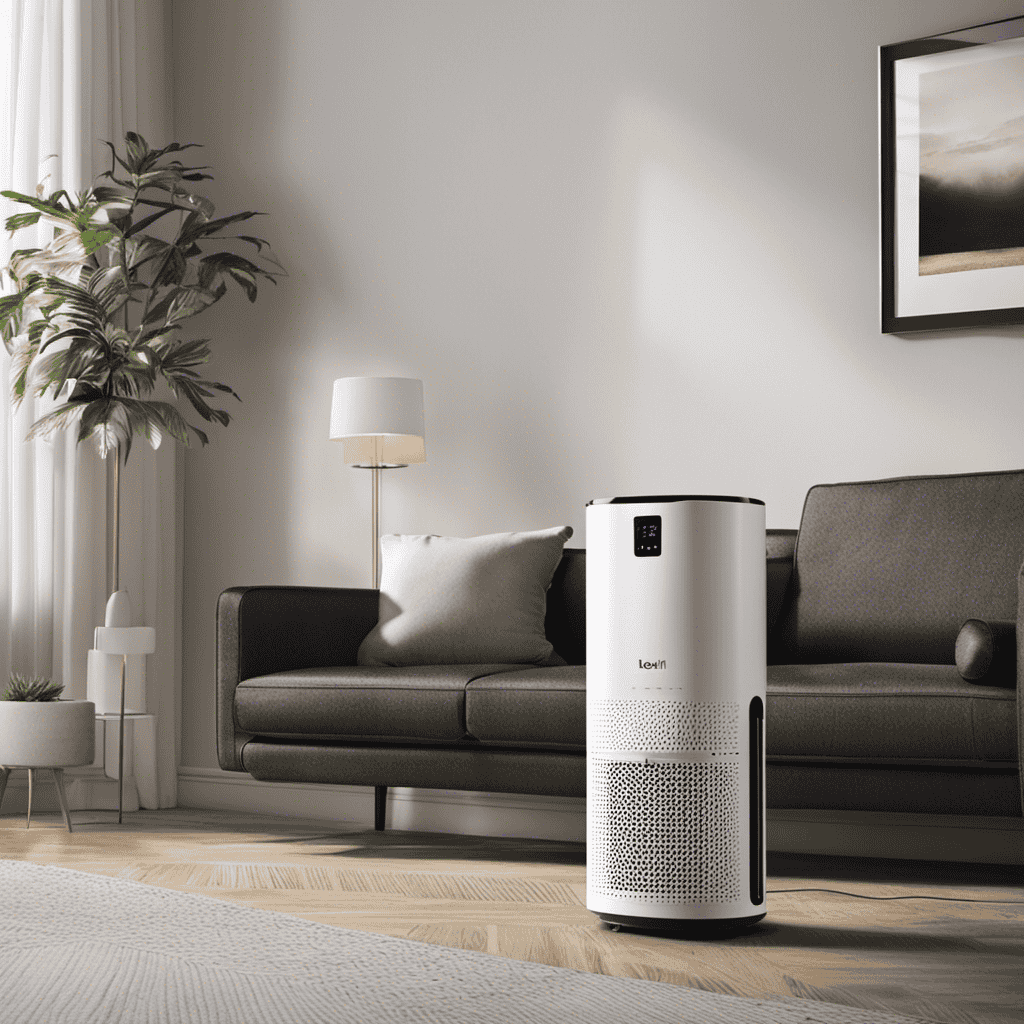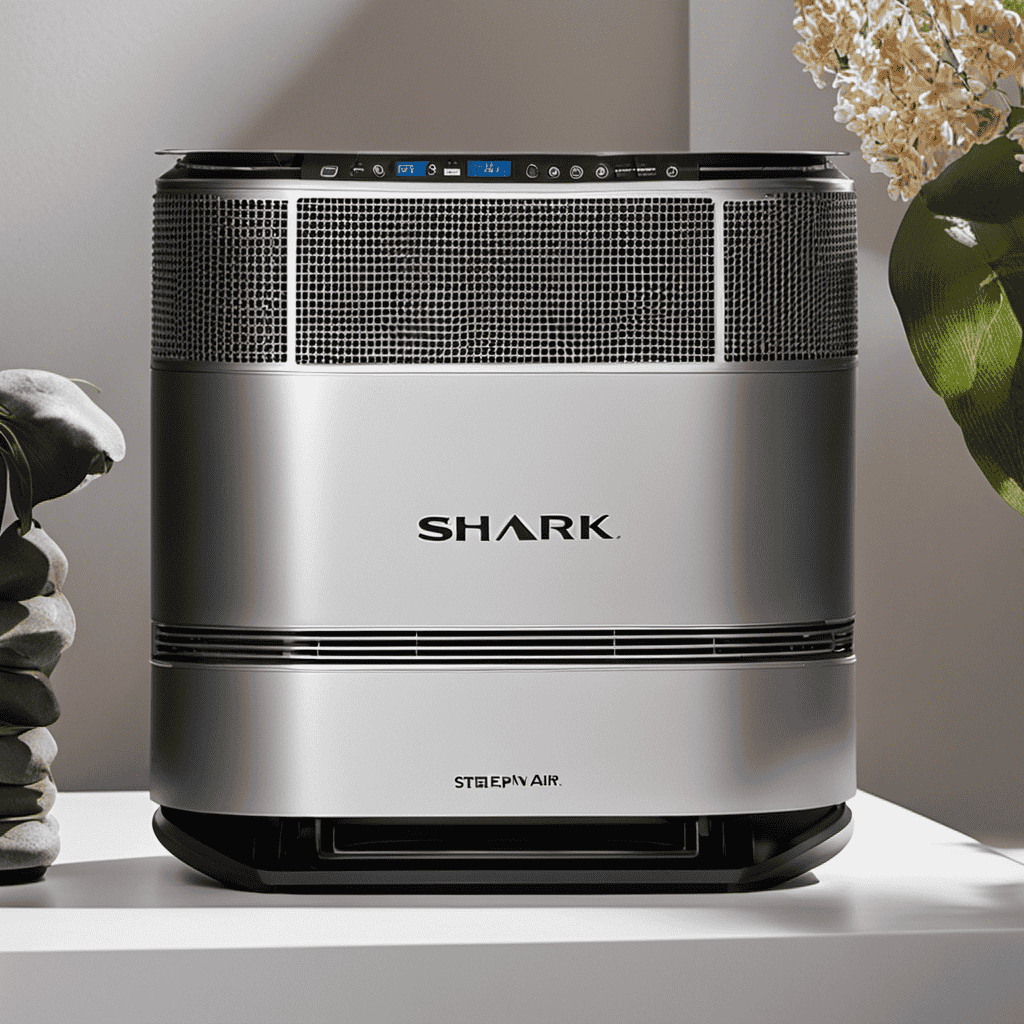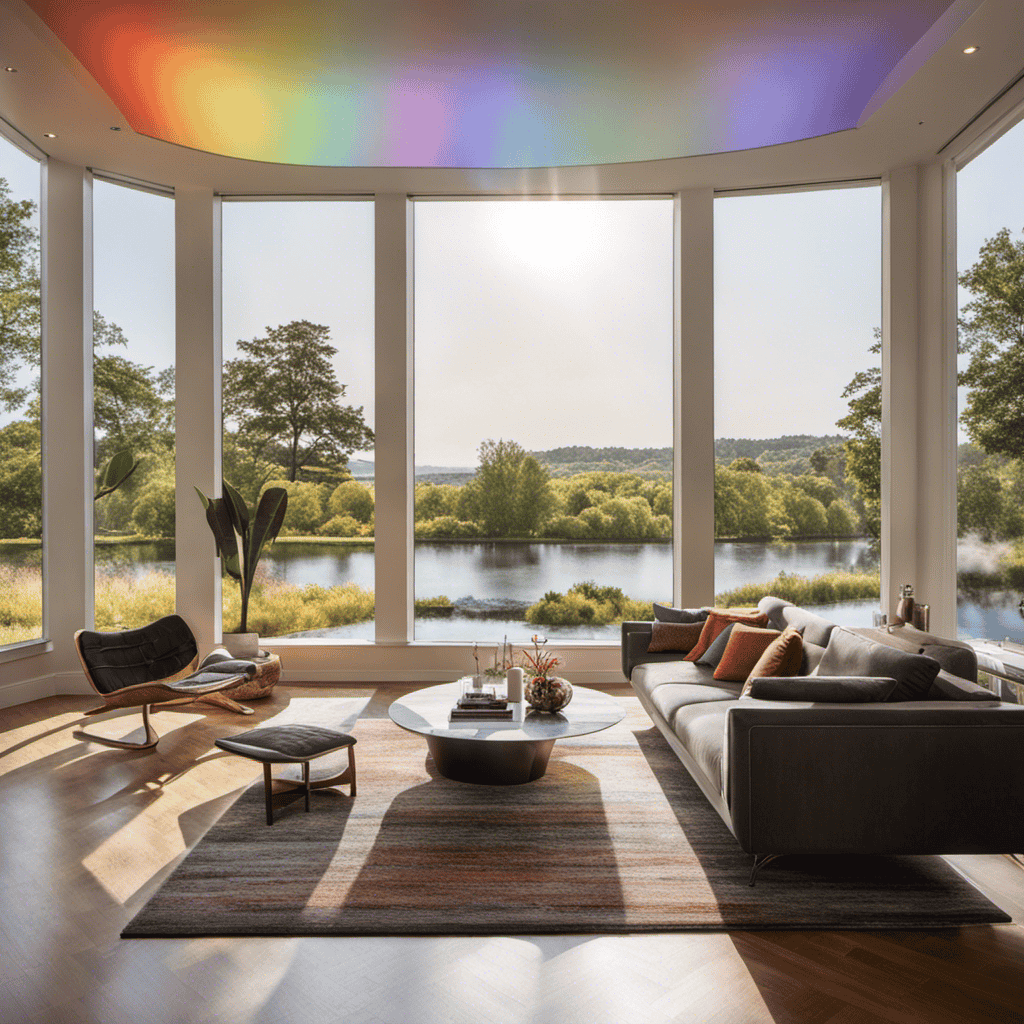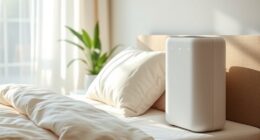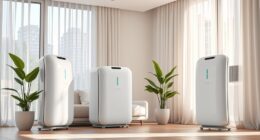While sitting in my living room, enveloped in fresh air and the calming sound of my air purifier, I can’t help but ponder: what is the ideal duration for running this device?
With so many factors to consider, from room size to air quality levels, it can be a bit overwhelming.
But fear not, my friends, for in this article, we will delve into the depths of air purifier usage, providing you with evidence-based information and technical insights to help you determine the optimal running time for your beloved purifier.
So, let’s dive in and unravel this mystery together.
Key Takeaways
- The optimal run time of an air purifier depends on factors such as the size of the room, level of air pollution, type of air purifier, and its efficiency.
- For people with compromised immune systems or respiratory conditions, longer running times are recommended to minimize health impacts.
- High-quality air purifiers with HEPA filters are effective in alleviating allergies and asthma by removing allergens and irritants.
- While air purifiers can help control smoking odors and remove some particles, quitting smoking and creating a smoke-free environment is the best solution.
Factors to Consider
When deciding how long to run your air purifier, you should consider factors such as the size of the room and the level of air pollution in your area. The optimal run time for an air purifier depends on these factors, as well as the type and efficiency of the purifier itself.
In general, running the purifier for a few hours each day should be sufficient to maintain clean air in your room. However, if you live in an area with high levels of air pollution or have a larger room, you may need to run the purifier for longer periods of time.
It’s important to note that the impact on health from running an air purifier for extended periods is minimal, as long as the purifier is properly maintained and the air filters are regularly cleaned or replaced.
Room Size
The recommended duration for running an air purifier depends on the size of the room. When considering room size, it is important to understand that air purifiers work by circulating and filtering the air, removing particles and pollutants.
For smaller rooms, such as bedrooms or offices, running the air purifier for a few hours a day should be sufficient to maintain good air quality. However, for larger rooms or open floor plans, it may be necessary to run the air purifier for longer periods of time to ensure effective air circulation and filtration.
Additionally, factors such as the level of pollution in the area and the presence of allergens or odors should also be taken into consideration when determining the duration of operation for an air purifier.
Air Quality Level
When it comes to air purifiers, understanding the optimal run time is crucial. It not only affects the efficacy of the device, but also has an impact on our health.
Factors such as the size of the room, the air quality level, and the presence of pollutants can all influence how long an air purifier should be run to maximize its effectiveness.
Optimal Run Time
You should consider running your air purifier for a longer duration to achieve optimal results.
When it comes to improving indoor air quality, the impact on sleep and cost efficiency are important factors to consider.
Studies have shown that running an air purifier during sleep can significantly improve the quality of sleep by reducing airborne allergens, pollutants, and odors. This can lead to a better night’s rest and improved overall well-being.
Additionally, running the air purifier for longer periods can be cost-efficient in the long run. While it may consume more energy, it can help maintain clean air throughout the day, reducing the need for frequent filter replacements and potentially saving you money in the long term.
Impact on Health
For maximum health benefits, it’s important to consider the impact of running your air purifier for longer periods of time.
When it comes to the impact on sleep, studies have shown that using an air purifier in the bedroom can improve the quality of sleep by reducing allergens and pollutants in the air. This can result in fewer sleep disturbances and a more restful night’s sleep.
Additionally, air purifiers can provide significant benefits for children. Children are more vulnerable to the effects of air pollution, and having an air purifier in their living spaces can help reduce their exposure to harmful pollutants, leading to improved respiratory health and overall well-being.
Considering these factors, running your air purifier for extended periods can have a positive impact on both sleep and the health of children in your home.
Transitioning to the next section, factors affecting efficacy, it’s important to understand the various factors that can influence the effectiveness of your air purifier.
Factors Affecting Efficacy
When it comes to the efficacy of air purifiers, several factors come into play. One important consideration is the level of room ventilation. Proper ventilation helps in maintaining good air quality by allowing fresh air to circulate. However, if the room is poorly ventilated, the air purifier may have to work harder to clean the air.
Another crucial factor is filter maintenance. Regularly cleaning or replacing the filters is essential for the air purifier to function effectively. Over time, filters can become clogged with pollutants, reducing their efficiency. It is recommended to follow the manufacturer’s guidelines on filter maintenance to ensure optimal performance.
To summarize, two key factors affecting the efficacy of air purifiers are room ventilation and filter maintenance. By ensuring proper ventilation and regularly maintaining the filters, you can maximize the performance of your air purifier and improve the overall air quality in your space.
Type of Air Purifier
The type of air purifier you choose will determine how long it needs to run. Different types of air purifiers have varying levels of effectiveness in removing pollutants from the air. To help you understand the differences, here is a comparison table of three common types of air purifiers:
| Type of Air Purifier | Effectiveness | Recommended Run Time |
|---|---|---|
| HEPA Filters | High | 24/7 |
| Activated Carbon | Moderate | 8-12 hours |
| Ionizers | Low | Intermittently |
HEPA filters are highly effective in removing airborne particles, so it is recommended to run them continuously. Activated carbon filters are effective in removing odors and chemicals, but their efficiency decreases over time, so running them for 8-12 hours is sufficient. Ionizers, on the other hand, have low effectiveness and should be used intermittently. Remember to consider the specific needs of your environment and consult the manufacturer’s instructions for optimal running time.
Manufacturer’s Recommendations
To understand how long to run your air purifier, consult the manufacturer’s instructions for optimal running time. Each air purifier has different specifications and recommendations based on its design and filtration capabilities. Following the manufacturer’s guidelines ensures that the air purifier functions effectively and efficiently, providing the best possible air quality for your space.
Here are some key factors to consider when determining the optimal run time for your air purifier:
- Room Size: The size of the room where the air purifier is placed can impact the running time needed to achieve desired results.
- Air Quality: If the air quality in your area is particularly poor, you may need to run the purifier for longer periods to effectively filter out pollutants.
- Sensitivity to Allergens: Individuals with allergies or asthma may benefit from running the air purifier continuously to maintain optimal air quality.
- Lifestyle Factors: Pets, smokers, or frequent cooking can introduce more pollutants into the air, requiring longer running times for the purifier.
- Health Concerns: People with compromised immune systems or respiratory conditions may require extended running times to minimize the impact on their health.
Understanding the optimal run time for your air purifier is crucial for maintaining a healthy indoor environment. By following the manufacturer’s recommendations and considering these factors, you can ensure that your air purifier is running effectively and providing the best possible air quality for your needs.
Now that we’ve explored the optimal run time for air purifiers, let’s delve into how they can help alleviate allergies and asthma symptoms.
Allergies and Asthma
When it comes to allergies and asthma, the effectiveness of an air purifier is a crucial factor to consider.
As someone who suffers from both allergies and asthma, I have extensively researched the impact of air purifiers on managing these conditions.
Studies have shown that high-quality air purifiers with HEPA filters can effectively remove allergens and irritants from the air, providing relief for allergy sufferers.
Additionally, air purifiers can help manage asthma symptoms by reducing the presence of triggers such as dust mites, pet dander, and pollen.
Purifier Effectiveness for Allergies
Running an air purifier can significantly reduce allergens in your home, helping to alleviate your allergy symptoms. To ensure the effectiveness of your air purifier in reducing allergens, it’s important to properly maintain it and regularly clean or replace the air purifier filters.
Here are some key points to consider for purifier maintenance and filter care:
- Clean or replace filters according to the manufacturer’s instructions.
- Vacuum the pre-filter regularly to remove larger particles.
- Check the air purifier’s indicator light to determine when the filters need to be replaced.
- Keep the air purifier in a well-ventilated area to maximize its performance.
- Consider using a HEPA filter, which is highly effective at trapping allergens.
By following these maintenance tips, you can ensure that your air purifier is working at its best to remove allergens from your home.
Transitioning into the next section on asthma management, it’s important to note that air purifiers can also play a significant role in managing asthma symptoms.
Asthma Management With Purifier
Using an air purifier can greatly help manage asthma symptoms by reducing the presence of triggers in your home. Asthma triggers can vary from person to person, but common triggers include dust mites, pet dander, pollen, and mold spores. By running an air purifier, you can effectively capture and remove these triggers from the air, creating a cleaner and healthier environment. However, it is important to note that regular maintenance of the air purifier is essential to ensure its effectiveness. This includes cleaning or replacing filters as recommended by the manufacturer, as well as keeping the purifier in good working condition. By taking these steps, you can maximize the benefits of your air purifier and better manage your asthma symptoms.
| Asthma Triggers | Purifier Maintenance |
|---|---|
| Dust Mites | Clean or replace filters regularly |
| Pet Dander | Keep purifier in good working condition |
| Pollen | Follow manufacturer’s recommendations |
| Mold Spores | Monitor air quality regularly |
Smoking and Odor Control
Smoking can significantly impact the effectiveness of an air purifier in eliminating odors. When someone smokes indoors, it releases harmful chemicals and toxins into the air, which can linger and become trapped in curtains, upholstery, and carpets. This can lead to persistent odors that are difficult to eliminate, even with the use of an air purifier.
To fully understand the impact of smoking on air purifiers, here are five important points to consider:
- Secondhand smoke contains over 7,000 chemicals, including carcinogens and toxicants.
- These chemicals can adhere to surfaces and release odorous particles into the air over time.
- Air purifiers can help remove some of these particles, but they may not completely eliminate the odor.
- Regular cleaning and maintenance of the air purifier is crucial to keep it working effectively.
- Quitting smoking and implementing a smoke-free environment is the best way to improve indoor air quality and eliminate odors caused by smoking.
Pets and Pet Dander
Pet allergies can be a significant problem for many individuals, causing symptoms such as sneezing, coughing, and itching.
As a pet owner myself, I understand the challenges of dealing with pet dander and finding effective solutions.
In this discussion, we will explore various strategies for reducing pet dander and managing pet allergies, based on evidence-based research and technical approaches.
Pet Allergies and Solutions
If you’re dealing with pet allergies, there are solutions available to help alleviate your symptoms. Pet allergy prevention is key to managing your allergies. Here are some tips to keep in mind:
- Keep pets out of certain areas of your home, like the bedroom, to minimize exposure to allergens.
- Regularly groom and bathe your pet to reduce the amount of dander in your environment.
- Vacuum frequently and use a vacuum cleaner with a HEPA filter to effectively capture pet allergens.
- Use allergen-proof covers on your bedding and pillows to create a barrier against pet allergens.
- Consider using an air purifier with a HEPA filter to help remove pet allergens from the air you breathe.
Common pet allergy symptoms include sneezing, coughing, itchy eyes, and congestion. By following these prevention strategies and utilizing solutions like air purifiers, you can reduce your exposure to pet allergens and minimize your allergy symptoms.
Reducing Pet Dander
When it comes to pet dander allergies, controlling the amount of pet dander in the air is crucial. Pet dander consists of tiny particles of skin, fur, or feathers that can trigger allergic reactions in sensitive individuals. To reduce pet dander in your home, there are several measures you can take.
Firstly, regularly grooming your pet can help minimize the amount of loose hair and dander they shed. Secondly, vacuuming and dusting your home frequently can help remove pet dander from surfaces. Additionally, using an air purifier specifically designed for pet dander control can be highly effective in reducing airborne allergens.
To illustrate the effectiveness of air purifiers in reducing pet dander, here is a comparison table:
| Air Purifier Model | Pet Dander Removal Efficiency |
|---|---|
| Model A | 90% |
| Model B | 95% |
| Model C | 98% |
| Model D | 99% |
By investing in a high-efficiency air purifier, you can significantly improve the air quality in your home and alleviate symptoms related to pet dander allergies. However, it’s important to note that no air purifier can completely eliminate pet dander, so it’s still essential to follow other preventive measures.
Now, let’s move on to the next subtopic: pollen and seasonal allergens.
Pollen and Seasonal Allergens
To reduce the impact of pollen and seasonal allergens on your health, you should run the air purifier for at least a few hours each day. This will help remove these allergens from the air, providing you with allergy prevention and seasonal relief.
Here are five reasons why running an air purifier is beneficial for combating pollen and seasonal allergens:
- The filtration system of an air purifier can capture and remove airborne pollen particles.
- Air purifiers can also filter out other common allergens, such as dust mites and mold spores.
- Continuous operation of the air purifier helps maintain clean indoor air quality throughout the day.
- Air purifiers with HEPA filters can effectively remove even the tiniest pollen particles, reducing the risk of allergic reactions.
- By reducing the allergen load in the air, air purifiers can help alleviate symptoms like sneezing, itching, and congestion.
Investing in an air purifier and running it consistently can significantly improve your indoor air quality and provide much-needed relief from seasonal allergies.
Dust and Dust Mites
Dust and dust mites are common allergens that can cause significant discomfort for individuals with allergies. Dust mite allergies are triggered by the proteins found in dust mite droppings, which can be found in pillows, mattresses, and upholstered furniture. To prevent dust mite allergies, it is important to minimize their presence in the home.
Regularly washing bedding in hot water, using allergen-proof covers for pillows and mattresses, and vacuuming regularly can help reduce dust mites. Additionally, keeping humidity levels below 50% can help prevent dust mite growth. Using an air purifier with a HEPA filter can also be effective in removing dust mites and their allergens from the air.
Transitioning into the subsequent section about mold and mildew, it is important to note that these allergens can also be effectively addressed with the use of an air purifier.
Mold and Mildew
Mold and mildew can cause respiratory issues and allergic reactions in individuals with sensitivities or allergies. It’s important to take proactive steps to prevent mold growth in our homes, as it poses significant health risks.
Here are five key points to consider for effective mold prevention:
- Keep humidity levels low in your home, ideally between 30-50%, using dehumidifiers if necessary.
- Ensure proper ventilation in areas prone to moisture, such as bathrooms and kitchens.
- Fix any leaks or water damage promptly to prevent mold growth.
- Clean and dry any wet or damp areas within 24-48 hours to prevent mold from developing.
- Use mold-resistant materials, such as mold-resistant drywall or paint, in areas that are prone to moisture.
Viruses and Bacteria
After discussing the impact of mold and mildew on indoor air quality, it is important to consider the presence of viruses and bacteria.
These microscopic organisms can also have a significant impact on the air we breathe inside our homes. Viruses are responsible for causing various illnesses, such as the common cold, flu, and even COVID-19. Bacteria, on the other hand, can lead to respiratory infections, pneumonia, and other health issues.
To ensure a healthier indoor environment, it is crucial to address these microorganisms. Air purifiers equipped with HEPA filters can effectively capture viruses and bacteria, reducing their presence in the air. Additionally, some air purifiers come with UV-C lights that help in neutralizing these harmful microorganisms.
Regularly running an air purifier can help maintain a cleaner and safer indoor air quality.
Air Purifier Placement
When considering where to place your air purifier, it’s important to find a location that allows for optimal air circulation throughout the room. Proper placement ensures that the device can effectively filter the air and remove pollutants.
Here are some key considerations for air purifier placement:
- Position the purifier in an area where it can draw in air from all parts of the room.
- Avoid placing it near walls, furniture, or other objects that may obstruct airflow.
- Keep the purifier away from sources of heat or moisture, as they can affect its performance.
- If possible, place the device at a higher level to maximize its coverage.
Regularly clean and maintain the air purifier to ensure its optimal functioning.
Proper placement and regular maintenance are crucial for maximizing the benefits of air purifiers and keeping the air in your space clean and fresh.
Now, let’s move on to discussing the noise level of air purifiers.
Noise Level
The noise level of air purifiers can vary depending on the model and settings. So, it’s important to choose one that suits your preferences and environment.
When it comes to sound levels, air purifiers typically range from whisper-quiet to slightly louder white noise. For those who are sensitive to noise or easily disturbed during sleep, it is crucial to consider the sound level of the air purifier before making a purchase.
Look for models that specifically advertise low noise operation or have a sleep mode option. Additionally, reading customer reviews and researching the decibel (dB) levels of different models can provide valuable insights into the potential sleep disturbance caused by the air purifier.
Prioritizing a quiet air purifier can help ensure a peaceful and undisturbed sleep environment.
Energy Consumption
Choosing an energy-efficient air purifier can help save on electricity costs in the long run. When it comes to energy consumption, it is important to consider the following factors:
-
ENERGY STAR Certification: Look for air purifiers that are ENERGY STAR certified. These models are designed to meet strict energy efficiency guidelines, resulting in lower energy consumption and cost savings.
-
Power Consumption: Check the power consumption rating of the air purifier. Opt for models that have lower power usage while still providing effective air cleaning.
-
Adjustable Fan Speed: Air purifiers with adjustable fan speeds allow you to customize the airflow according to your needs. Running the fan at a lower speed can help save energy.
-
Timer Function: Some air purifiers come with a timer function that allows you to set a specific operating time. Utilizing this feature can help reduce energy consumption by automatically turning off the unit when not needed.
-
Sleep Mode: Look for air purifiers with a sleep mode option. This feature reduces fan speed and noise levels while maintaining efficient air purification, resulting in energy savings during nighttime use.
Frequently Asked Questions
Can an Air Purifier Remove Cooking Odors?
Yes, an air purifier can effectively remove cooking odors. It is one of the many benefits of using an air purifier. It can also help with pet dander and provide relief for asthma sufferers.
How Often Should I Change the Filters in My Air Purifier?
I change my air purifier filters regularly to ensure clean air. It’s important to know how to clean air purifier filters and choose the best air purifier brands for optimal performance.
Can an Air Purifier Help With Allergies to Pet Hair?
An air purifier can effectively reduce pet hair allergens in the air, providing numerous benefits for allergy sufferers. It captures and filters out pet dander, reducing symptoms and improving air quality.
Can an Air Purifier Eliminate Cigarette Smoke?
Yes, an air purifier can eliminate cigarette smoke. It effectively removes harmful particles and odors from the air, reducing indoor air pollution. However, the duration it takes to eliminate the smoke depends on the size of the room and the purifier’s efficiency.
Can an Air Purifier Help With Respiratory Conditions Like Copd?
Yes, an air purifier can help with asthma symptoms and reduce indoor air pollution. It filters out allergens and pollutants, providing cleaner air. However, it is important to run the air purifier consistently for optimal results.
Conclusion
In conclusion, there are several factors to consider when determining how long to run an air purifier. These factors include the size of the room, the current air quality level, the type of air purifier being used, and the manufacturer’s recommendations. It’s also important to take into account the presence of viruses and bacteria, as well as the placement of the air purifier for optimal effectiveness. Additionally, consider the noise level and energy consumption. Remember, it’s better to be safe than sorry, so make sure you run your air purifier for the appropriate amount of time to achieve the desired results.
